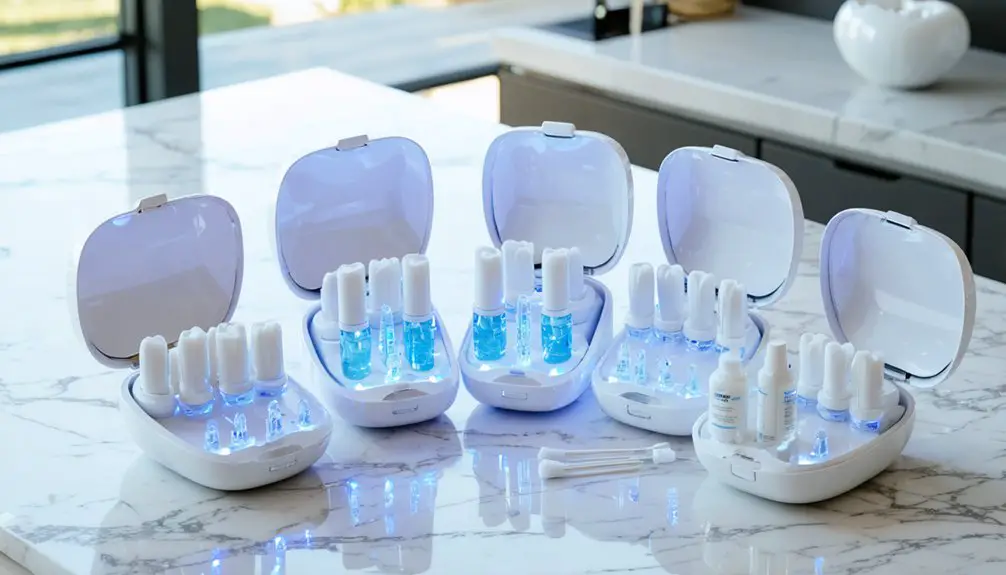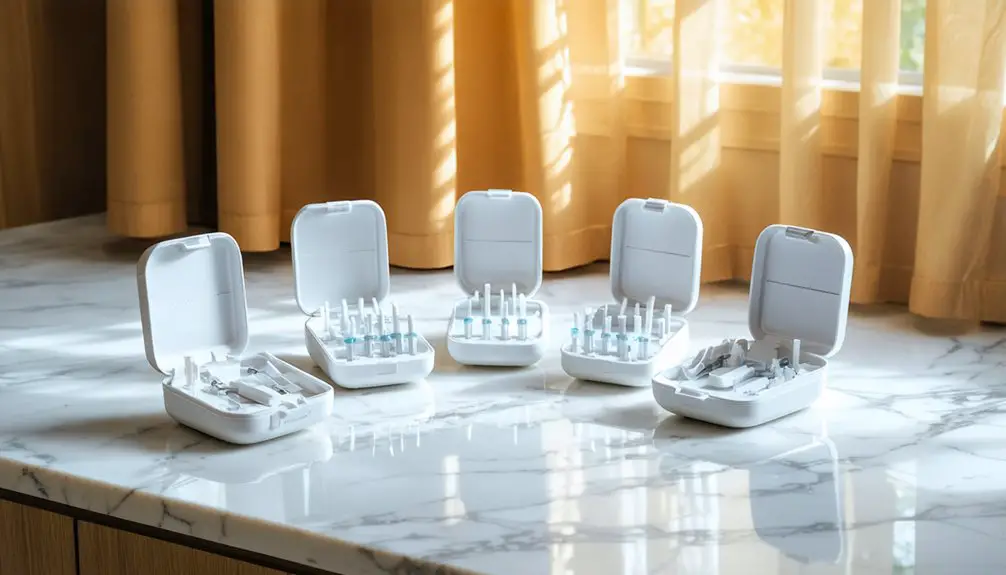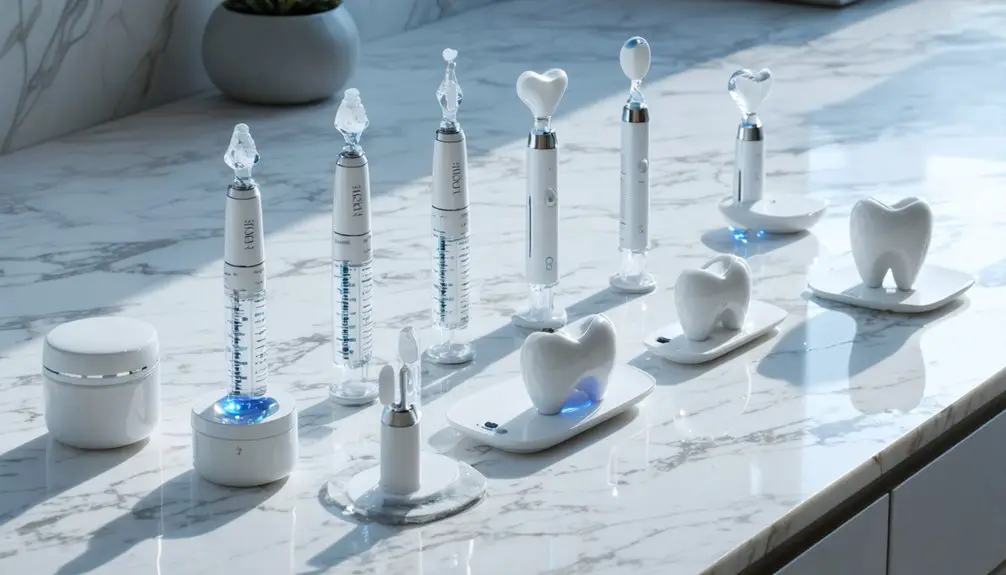For sensitive teeth, you’ll find effective whitening solutions in several top-rated home kits. Crest 3DWhitestrips Sensitive + LED Light delivers a 2.6 shade improvement while minimizing discomfort. Custom-fitted trays from Smile Brilliant offer precise control over peroxide exposure, and Oralgen NuPearl provides gentle brightening of 2.1 shades within a week. LED technology enhances results while reducing sensitivity compared to traditional methods. Exploring these sensitivity-safe options will help you achieve the best whitening with minimal irritation.
Key Takeaways
- Crest 3DWhitestrips Sensitive + LED Light system delivers 2.6 shade improvement while incorporating enamel-safe hydrogen peroxide formulation.
- Custom-fitted trays from Smile Brilliant provide precise control over peroxide exposure and minimize gum contact for sensitive users.
- Oralgen NuPearl offers gentle whitening with documented results of 2.1 shade improvement within seven days of twice-daily use.
- LED whitening systems produce less sensitivity than traditional methods and achieve faster results in 30-60 minutes.
- Products containing potassium nitrate and hydroxyapatite effectively whiten while strengthening enamel and reducing tooth sensitivity.
Understanding Sensitivity-Safe Whitening Technologies
While many people desire whiter teeth, those with sensitivity must approach teeth whitening with extra caution and knowledge. Understanding sensitivity causes is essential – whitening agents can irritate exposed dentin tubules and nerve endings, especially when enamel is already compromised or gums have receded. Hot and cold foods can trigger discomfort during the whitening process.
Sensitive teeth require a thoughtful approach to whitening, as compromised enamel and exposed nerves can react strongly to bleaching agents.
Today’s sensitivity-safe technologies offer several effective options. LED systems with adjustable blue light provide controlled whitening without heat production, while custom-fitted trays allow for lower-concentration gels over extended periods. Carbamide peroxide offers a gentler alternative for achieving whiter teeth with less irritation.
Products containing desensitizing ingredients like potassium nitrate or fluoride help block nerve responses and strengthen enamel during treatment. You’ll find that professional-grade kits often combine gentle peroxide levels (under 6%) with soothing agents, delivering gradual whitening results while protecting sensitive teeth.
Natural alternatives using mild abrasives offer an even gentler approach for severe sensitivity cases.
Best At-Home Whitening Solutions for Sensitive Teeth
Armed with knowledge about sensitivity-safe technologies, you can now explore specific at-home whitening solutions designed for sensitive teeth. Your safest options include Crest 3DWhitestrips Sensitive + LED Light, which removes decades of stains using enamel-safe hydrogen peroxide, showing an average improvement of 2.6 shades with minimal sensitivity risks. A 30-minute daily treatment ensures optimal results while maintaining comfort during the whitening process.
For daily maintenance, Sensodyne Extra Whitening toothpaste offers gradual brightening while strengthening enamel. Additionally, Oralgen NuPearl whitens teeth by 2.1 shades in just one week of twice-daily use.
If you’re seeking professional-grade results, custom-fitted trays from Smile Brilliant allow precise control over peroxide exposure and treatment duration. Whitening pens provide targeted application for quick touch-ups, though they’re less effective for full-mouth whitening.
User experience reviews consistently favor custom trays and sensitivity-formulated strips for their balanced approach to whitening ingredient comparisons, delivering noticeable results while prioritizing comfort.
Comparing LED Light Vs Traditional Whitening Methods
Because LED whitening technology represents a significant advancement in dental care, understanding its key differences from traditional methods can help you make an informed choice for your teeth.
The LED advantages include faster results, achieving multiple shades of whitening in just 30-60 minutes, compared to traditional methods that can take weeks or months. Professional treatments cost between $300 to $1000 but deliver superior results. Professional supervision by certified specialists ensures optimal safety and effectiveness during the procedure.
You’ll experience less sensitivity with LED treatments since they don’t generate heat and use specially formulated gels.
Traditional limitations include slower chemical reactions, uneven whitening, and often more tooth sensitivity due to prolonged exposure to peroxide.
While traditional methods rely solely on chemical agents, LED technology’s light activation enhances gel penetration for deeper stain removal.
LED treatments also provide longer-lasting results, typically 3-6 months, while traditional methods require more frequent touch-ups to maintain whiteness.
Key Features to Look for in Gentle Whitening Products
When selecting whitening products for sensitive teeth, you’ll need to focus on specific gentle formulation features that protect your enamel while achieving desired results.
Look for products containing potassium nitrate and hydroxyapatite, two key sensitivity indicators that help minimize discomfort and strengthen tooth structure.
Advanced LED technology used in systems like SNOW® Blue LED enhances serum penetration for more effective and comfortable whitening results.
Choose formulations with lower concentrations of hydrogen peroxide or carbamide peroxide to guarantee ingredient safety while still effectively whitening.
The best products will include enamel-strengthening compounds and avoid harsh abrasives.
Pay attention to delivery systems – pre-filled trays or strips with comfortable grips provide controlled dosing and proper placement.
Regular consultation with dental professionals ensures you’re using the most appropriate whitening method for your sensitivity level.
For ideal protection, select products that incorporate remineralizing agents like amorphous calcium phosphate or fluoride.
Always verify that products carry ADA approval or dentist recommendations for sensitive teeth.
Expert Tips for Safe and Effective Home Whitening
Professional guidance sets the foundation for safe and effective home teeth whitening. Before starting any treatment, schedule whitening consultations with your dentist to assess your oral health and receive personalized recommendations.
They’ll help determine if you’re a suitable candidate and guide you in selecting products that match your sensitivity level. Lower-strength whitening products containing hydrogen peroxide are safer for sensitive teeth while still being effective.
- Always follow product instructions precisely, including application times and frequency, to prevent enamel damage and gum irritation.
- Use custom-fitted trays when possible, as they provide better coverage and minimize contact with sensitive gum tissue.
- Monitor your teeth’s response during treatment and discontinue use if you experience prolonged sensitivity or discomfort.
For best results, maintain regular dental check-ups and avoid staining substances after treatment. The gradual application process helps reduce discomfort while achieving natural-looking results.
Remember to use sensitivity-specific toothpaste and apply desensitizing agents as recommended by your dental professional.
Frequently Asked Questions
Can I Whiten My Teeth if I Have Crowns or Veneers?
Like trying to paint a canvas with mixed materials, you can’t whiten crowns or veneers, though your natural teeth will brighten. For veneers’ safety, consult your dentist about alternatives like replacement restorations.
How Long Should I Wait Between Whitening Treatments to Avoid Sensitivity?
You should wait 24-72 hours between treatments for proper sensitivity management. If discomfort persists, extend your treatment frequency to weekly intervals and consider using desensitizing products between sessions.
Will Drinking Coffee Through a Straw Prevent Teeth Staining?
Want to protect your smile? Using a straw isn’t a complete solution – it’ll only reduce front tooth staining. You’ll still need proper dental care and might consider coffee alternatives for better results.
Can Pregnancy Affect the Safety of Using Teeth Whitening Products?
You shouldn’t use teeth whitening products during pregnancy since pregnancy hormones increase sensitivity and dental safety risks. Consult your healthcare provider, as research on potential fetal effects is limited.
Should Whitening Products Be Avoided Right After Dental Cleaning or Fillings?
You’ll need to wait after dental work to avoid increased teeth sensitivity. Delay whitening for several days post-cleaning or fillings to protect your dental hygiene and guarantee ideal treatment results.
References
- https://crest.com/en-us/oral-care-products/3d-whitestrips/crest-3dwhitestrips-sensitive-led-light-at-home-teeth-whitening-kit
- https://www.goochlanddentistry.com/whats-the-best-teeth-whitener-for-sensitive-teeth/
- https://www.goodhousekeeping.com/health-products/g28723133/best-at-home-teeth-whitening-products/
- https://www.cnet.com/health/personal-care/best-teeth-whitening-kits/
- https://nhdentistrybeverlyhills.com/press/6-of-the-best-teeth-whitening-kits-in-the-drugstore/
- https://www.blvddentistry.com/can-you-get-whitening-treatment-with-sensitive-teeth/
- https://www.advancedsmilesmarion.com/resources/best-teeth-whitening-technology
- https://smiledailey.com/teeth-whitening-for-sensitive-teeth-is-it-safe/
- https://buforddentist.com/what-are-the-best-whitening-options-for-sensitive-teeth/
- https://www.sensodyne.com/en-us/oral-health-tips/whitening-sensitive-teeth/what-to-know/



